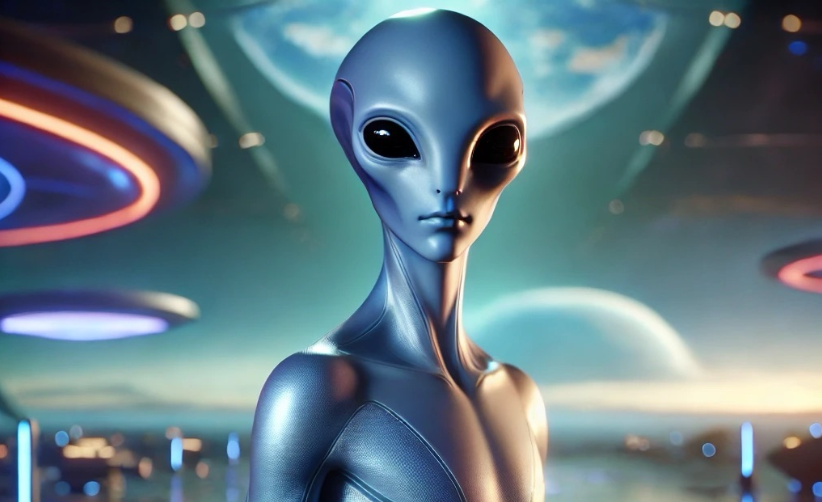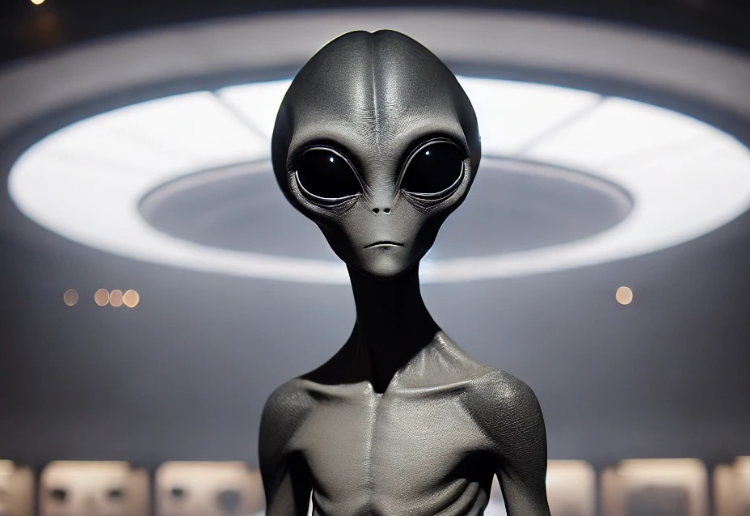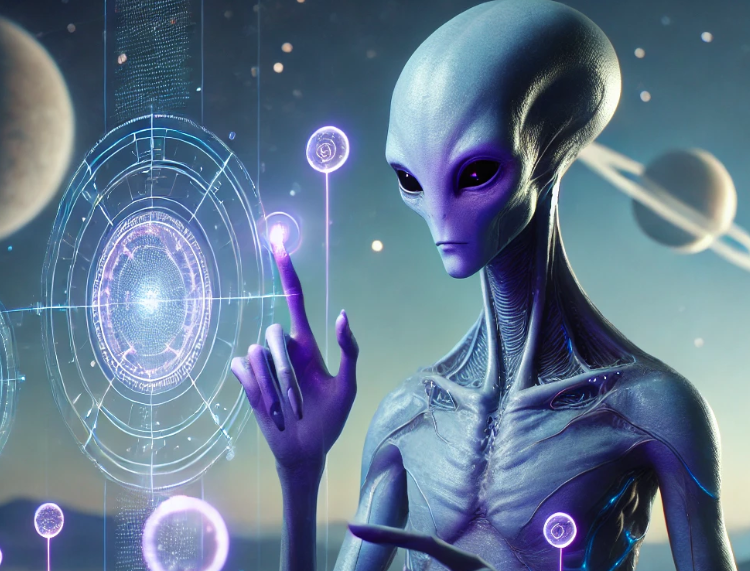Throughout history, numerous accounts of extraterrestrial encounters have described humanoid alien species. These entities, often sharing a striking resemblance to humans, have become central figures in UFO lore. From ancient cave drawings to modern-day abductions, humanoids continue to intrigue researchers and believers alike. In this post, we’ll delve into the characteristics of these beings, their reported origins, and the potential implications of their visits.
ORIGINS OF HUMANOID SPECIES
One of the most curious aspects of humanoid aliens is their similarity to us. Why would beings from distant planets evolve to look like humans? Some theories suggest that there may be a universal blueprint for intelligent life, with humanoid forms being the most efficient for survival and technological advancement. Others propose that these beings are distant relatives or share some cosmic connection with humanity. This leads many to speculate whether their presence on Earth stretches back much further than we think.
Some scholars and researchers believe that humanoid extraterrestrials have influenced human history for thousands of years. Ancient astronaut theorists, for example, point to ancient texts, carvings, and legends that depict god-like beings descending from the skies. Could these beings have been humanoid aliens guiding early civilizations? Sites like Egypt’s pyramids, Stonehenge, and the Nazca Lines have all been linked to potential extraterrestrial involvement, their builders possibly influenced by beings from other worlds.
Humanoid aliens have been reported in various cultures and time periods, from the Nordic-like beings seen in Scandinavian mythology to the Greys, a species often described in modern abduction stories. Their origins are often linked to distant star systems like the Pleiades, Zeta Reticuli, and even nearby planetary bodies within our solar system. Some believe they may have visited Earth for millennia, influencing ancient civilizations with advanced technology and knowledge. The striking similarities between some human religious figures and these humanoid alien species have only fueled speculation about a potential link between ancient deities and extraterrestrial visitors.
COMMON HUMANOID ALIEN TYPES
Several humanoid species have been reported over the decades, with the following being the most notable:
1. The Greys:
Perhaps the most well-known alien species, Greys are characterized by their short stature, large heads, and almond-shaped eyes. They are frequently associated with abductions and medical experiments. Witnesses often describe these beings as emotionless and highly intelligent, possibly acting as a worker class for other alien civilizations.
Some theorists believe that the Greys may not even be organic beings, but rather some form of artificial intelligence or bioengineered workers created by a more advanced alien race. Their seemingly detached, robotic behavior during abductions has led to speculation that they are simply following commands, carrying out specific tasks such as monitoring human genetics or conducting biological research.
2. The Nordics:
Standing over six feet tall with blonde hair, blue eyes, and Scandinavian-like features, the Nordics are said to be peaceful and benevolent. Many contactees claim these beings come from the Pleiades star cluster and possess advanced spiritual and technological knowledge. The Nordics are often described as warning humanity about its destructive tendencies and offering guidance for future growth.
In contactee reports, Nordics have often been depicted as human guardians, intervening subtly in world affairs to guide humanity away from potential catastrophes. Their messages are typically centered on environmental preservation, peace, and the advancement of human spirituality. The idea that they have been quietly watching over humanity for centuries has drawn comparisons to angelic figures in various religious texts.
3. The Reptilians:
Unlike the Greys and Nordics, Reptilians are often associated with malevolence and control. Described as tall, muscular beings with reptilian features, these entities are thought to originate from Alpha Draconis and have infiltrated human societies to exert control from behind the scenes. Conspiracy theorists believe they have established powerful positions within global governments and financial institutions.
Reptilians are frequently linked to theories of a global shadow government, with some suggesting that they have used their advanced technology and psychic abilities to manipulate human affairs for millennia. Reports of shape-shifting Reptilians infiltrating human society are common in conspiracy circles, and they are often depicted as ruthless, cold-blooded beings with a singular desire for control.
4. The Tall Whites:
Similar to the Nordics, the Tall Whites are humanoid aliens reported to be taller than the average human. Their pale complexion and elongated limbs set them apart from other species. Often described as reserved and distant, the Tall Whites are thought to come from distant star systems and are less frequently encountered than other humanoid species.
In several reported encounters, the Tall Whites have been said to possess immense technological capabilities, far beyond what humanity currently understands. Some believe they act as neutral observers, studying Earth and its inhabitants from afar. Unlike other humanoid species, the Tall Whites rarely intervene in human affairs and are described as more elusive, only interacting when necessary.
WHY HUMANOID FORM?
A prevalent question in the study of extraterrestrial beings is: why would aliens resemble humans? Some suggest convergent evolution, where similar environments in the cosmos lead to the development of comparable forms. Others argue that the humanoid form might be optimal for interstellar travel, technological advancement, and survival.
The theory of panspermia also offers an intriguing explanation. According to this hypothesis, life throughout the universe may share a common origin, possibly seeded by comets or meteoroids. If this were the case, it’s possible that life on other planets might have evolved in similar ways, resulting in species that look remarkably like us. This could explain the humanoid appearance of many alien species, suggesting that they, too, are part of a shared cosmic ancestry.
Moreover, the anthropocentric perspective—humans assuming that alien life must resemble them—might shape these accounts. Psychological and cultural influences could explain why many abductees and contactees report seeing humanoid forms, with pop culture playing a significant role in the depiction of extraterrestrial visitors. Movies, television shows, and books have solidified the image of aliens as humanoid, influencing how people interpret their experiences.
ENCOUNTERS AND IMPLICATIONS
Humanoid alien encounters range from peaceful exchanges of knowledge to terrifying abductions and experiments. Accounts of these beings are found across multiple cultures, leading researchers to speculate on their intentions. Could they be observing us as part of an intergalactic experiment, or are they guiding us toward a greater future?
Many abductees report consistent experiences with humanoid aliens. Whether it’s being taken aboard a spacecraft for medical examinations or receiving cryptic messages about the future of humanity, these encounters leave a profound impact on those involved. Some abductees describe the experiences as traumatic, while others report feelings of enlightenment and connection with the cosmos.
There is also the possibility that some humanoid species are here to monitor human development. Researchers speculate that their presence might be linked to pivotal moments in human history—watching, and perhaps even influencing, major events. While some theories suggest benevolent guidance, others propose a more sinister agenda, where humans are being subtly manipulated by these beings.
HUMANOIDS IN MODERN UFOLOGY
Humanoid aliens remain a central focus in modern UFO research. Their frequent appearances in abduction cases and contactee stories have led to an ongoing investigation into their intentions and relationship with humanity. UFO researchers like J. Allen Hynek and Dr. David Jacobs have long studied the role of these beings in the broader context of extraterrestrial contact, leading to theories ranging from peaceful co-existence to hidden agendas involving human control and experimentation.
Furthermore, the rise of government disclosure efforts, such as the U.S. Pentagon’s acknowledgment of UFO phenomena, has reignited public interest in humanoid species. With more sightings and encounters being declassified, researchers are eagerly investigating whether any documented incidents point to the presence of humanoid extraterrestrial visitors.
CONCLUSION
Humanoid alien species are central figures in the UFO and extraterrestrial phenomena, but definitive proof remains elusive. From the Greys to the Nordics, these beings have shaped modern perceptions of alien life. As we continue to explore the possibilities of extraterrestrial contact, the humanoid alien species will likely remain a cornerstone of our curiosity about what lies beyond Earth.








